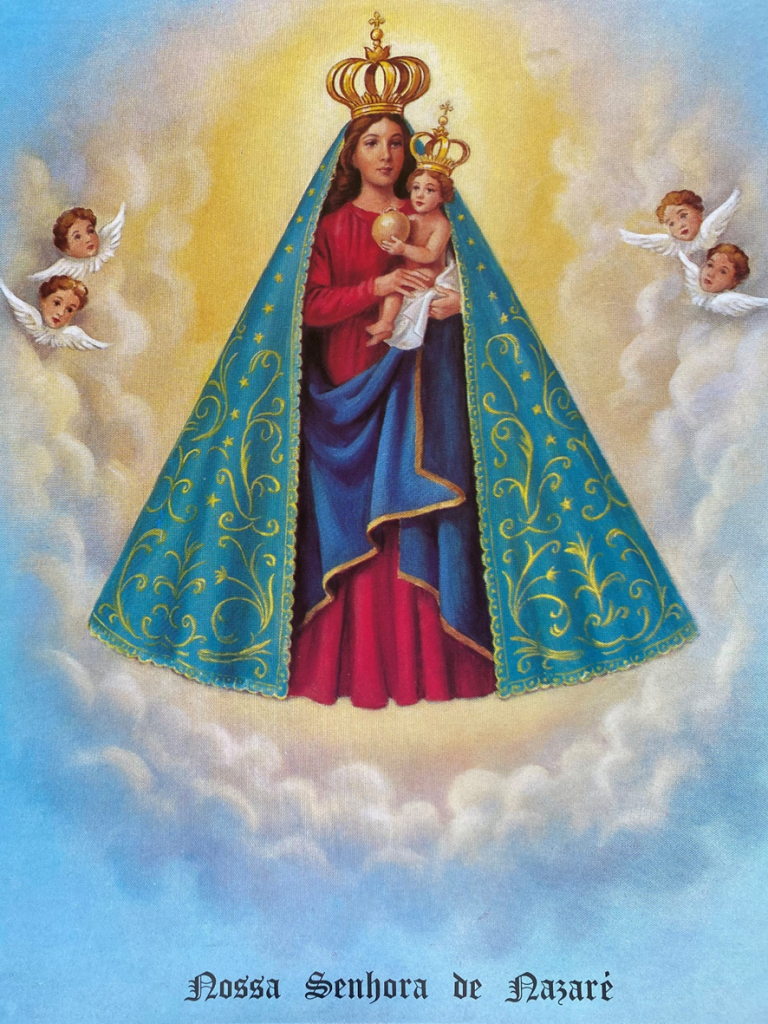

Nossa Senhora de Nazaré
Oração
“Virgem Imaculada, Mãe de Deus e Nossa Mãe, que Vos dignastes abrir nesse Santuário a fonte das Vossas graças mais singulares, eis-me prostrado aos pés da Vossa veneranda e milagrosa imagem.
Suplico-Vos, ó Nossa Senhora de Nazaré, com a mais filial confiança. Livrai-nos a mim e aos que me são caros, aos saquaremenses, e a todos os brasileiros, dos males que nos afligem, e concedei-nos os favores e as graças de que necessitamos.
Mãe de misericórdia, pela Sagrada Paixão de Vosso Divino Filho, pelas dores e angústias de Vosso coração materno, tende compaixão de mim, dos saquaremenses, dos brasileiros: não me deixeis sair desse Vosso santuário sem que primeiro tenhais apresentado ao Vosso caro Jesus as minhas ardentes súplicas.
Abençoai-me, ó minha Mãe.
Espero em Vós, e sei que não esperarei em vão!”
História
Parece que a devoção à Nossa Senhora de Nazaré teve origem em Portugal, mas as narrativas que envolvem este título de Maria no Brasil são diferentes das do país luso. Interessa, pois neste momento qual a origem do mais importante título de Maria no Estado do Pará, em nosso país.
Conta-se que um homem de nome Placido teria encontrado uma imagem em madeira de Nossa Senhora Nazaré (então já cultuada em Portugal, que atribuía a escultura da imagem de Maria a criação do próprio São José, em tempos em que ainda viviam naquela terra) nas margens do igarapé Murutucu.
Imaginou que algum devoto da cidade a tivesse ali perdido, e levou-a para casa, no dia seguinte, a imagem não estava mais onde Plácido a havia colocado, e ele a encontrou de novo no mesmo igarapé. Levou a imagem de novo para casa, e de novo ocorreu o mesmo fato. Diante disso, a imagem foi levada para a capela do Palácio do Governo da Provincia, onde ficou guardada por grande escolta.
Todavia, na manhā seguinte, a imagem já não estava mais ali; novamente foi encontrada no igarapé. Assim, foi erguida uma capela para Nossa Senhora de Nazaré à beira do igarapé, de onde a imagem jamais escapuliu.
Foi assim o início das romarias e da grande devoção dos paraenses à Nossa Senhora de Nazaré. Na tarde de 8 de setembro de 1793, foi realizada a primeira procissão do Círio de Nossa Senhora de Nazaré. Alguns anos mais tarde, a famosa procissão foi transferida para o segundo domingo de outubro, e, passados mais de duzentos anos, o mesmo percurso de cinco quilômetros entre o Palácio do Governo e a capela é realizado anualmente. Só que hoje, no lugar da pequena capela, há a imponente Basílica de Nossa Senhora de Nazaré.
Our Lady of Nazareth
Prayer
Immaculate Virgin, Mother of God and Our Mother, who deigned to open in this Sanctuary the source of Your most singular graces, here I am prostrated at the feet of Your venerable and miraculous image.
I beg You, O Our Lady of Nazareth, with the most filial confidence. Free us and those dear to me, the people of Saquarem, and all Brazilians, from the evils that afflict us, and grant us the favors and graces we need.
Mother of mercy, for the Sacred Passion of Your Divine Son, for the pains and anguish of Your maternal heart, have compassion on me, on the people of Saquarem, on the Brazilians: do not let me leave this sanctuary of Yours without first presenting to Your dear Jesus my ardent supplications.
Bless me, O my Mother.
I hope in You, and I know that I will not wait in vain!“
History
It seems that devotion to Our Lady of Nazareth originated in Portugal, but the narratives surrounding this title of Mary in Brazil are different from those in the Portuguese country. It is interesting, at this moment, what is the origin of the most important title of Mary in the State of Pará, in our country.
It is said that a man named Placido found a wooden image of Our Lady of Nazareth (then already worshiped in Portugal, which attributed the sculpture of the image of Mary to the creation of Saint Joseph himself, in times when they still lived in that land). on the banks of the Murutucu stream.
He imagined that some devotee from the city had lost it there, and took it home. The next day, the image was no longer where Plácido had placed it, and he found it again in the same stream. He took the image home again, and the same thing happened again.
Therefore, the image was taken to the chapel of the Provincial Government Palace, where it was guarded by a large escort. However, the following morning, the image was no longer there; again it was found in the stream. Thus, a chapel was built for Our Lady of Nazaré on the banks of the stream, from where the image never escaped.
This was the beginning of the pilgrimages and the great devotion of the people of Pará to Our Lady of Nazaré.
On the afternoon of September 8, 1793, the first procession of the Círio de Nossa Senhora de Nazaré took place. A few years later, the famous procession was moved to the second Sunday in October, and, more than two hundred years later, the same five-kilometer route between the Government Palace and the chapel is carried out annually.
But today, in place of the small chapel, there is the imposing Basilica of Nazareth.
Fonte: Ave, Maria – Memnon Edições Científicas – 2014
Produzido por

Consulte a Agenda do Museu a partir de 2025 e o visite quando receber sua confirmação de visita em seu email ou whatsapp.
Por se tratar de um museu particular, é necessário se cadastrar na Comunidade MuMi e customizar sua visita.
Criação e Tecnologia: Clayton Tenório @2025 MuMi – Museu Mítico